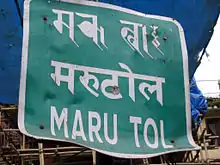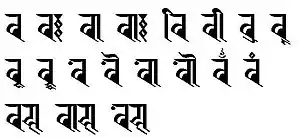Ranjana script
The Rañjanā script (Lantsa[2]) is an abugida writing system which developed in the 11th century[3] and until the mid-20th century was used in an area from Nepal to Tibet by the Newar people, the historic inhabitants of the Kathmandu Valley, to write Sanskrit and Newari. Nowadays it is also used in Buddhist monasteries in India; China, especially in the Tibetan Buddhist areas within the Tibet Autonomous Region, Sichuan, Yunnan, Qinghai and Gansu; Mongolia, and Japan.[3] It is normally written from left to right but the Kutakshar form is written from top to bottom.[3] It is also considered to be the standard Nepali calligraphic script.
| Rañjanā | |
|---|---|
 | |
| Type | |
| Languages | Newar Sanskrit Tibetan |
Time period | c. 1100–present |
Parent systems | |
Child systems | Soyombo |
Sister systems | Prachalit Bhujimol |
| Direction | Left-to-right |
| ISO 15924 | Ranj, 303 |
| Brahmic scripts |
|---|
| The Brahmic script and its descendants |


Development
Rañjanā is a Brahmic script which developed around 1100 AD. It is used in India and in Nepal by the Newar people to write the Newar language.[2] The script is also used in most of the Mahayana and Vajrayana monasteries.[4] Along with the Prachalit Nepal alphabet, it is considered as one of the scripts of Nepal.[5] It is the formal script of Nepal duly registered in the United Nation while applying for the free Nation. Therefore, it is a vital script to all Nepalese as well.
The Aṣṭasāhasrikā Prajñāpāramitā Sūtra lettered in gold ink by Bhiksu Ananda of Kapitanagar and dating back to the Nepal Sambat year 345 (1215 CE) is an early example of the script.[6]
Alphabet
Vowels

Consonants
Vowel diacritics




These are the rules for vowel diacritics in Ranjana script. There are altogether three rules where the vowel diacritics of क, ग and ब are given.
- ख, ञ,ठ,ण,थ,ध,श uses the rule of ग
- घ,ङ,च,छ,झ,ट,ड,ढ,त,द,न,न्ह,प,फ,ब,भ,म,य,र,ह्र,ल,ल्ह,व,व्ह,ष,स,ह,त्रuses the rule of ब
- ज,म्ह,ह्य,क्ष, ज्ञ uses the rule of क
Numerals
Use


Rañjana is mostly used for printing Hindu and Buddhist scriptures and literature in Sanskrit and Buddhist Hybrid Sanskrit used by the Newar community. Rañjana is also in current use for printing “high status” documents (wedding invitations, certificates, etc) in Nepal in the Newar language and for Newar language book titles.[7][8] In Mahayana and Vajrayana Buddhist traditions, it is famously used to write various mantras including the "Om mani padme hum" mantra of Avalokiteśvara, the mantra of Tara: "Om tare tuttare ture svaha", and the mantra of Manjusri: "Om ara pa cana dhi."[9][10][11] The script is also used in Hindu scriptures.[12]
In Chinese Buddhism and other East Asian Buddhism, the standard Sanskrit script for mantras and dhāraṇīs was not the Rañjanā script, but rather the earlier Siddhaṃ script that was widely propagated in China during the Tang dynasty.[13] However, in late Imperial China, the influence of Tibetan Buddhism popularized the Rañjanā script as well, and so this script is also found throughout East Asia, but is not as common as Siddhaṃ.[14]
Use in Tibet
When Rañjanā was introduced to Tibet, it was referred to as Lanydza (Tibetan: ལཉྫ་ ), which simply derives from the Sanskrit word Rañja.[13] This script varies slightly from the standard Rañjanā. In Tibet, the Lanydza variant is used to write original texts of Sanskrit.[15] Examples of such texts include the Mañjuśrīnāmasamgīti, the Diamond Sutra and the Aṣṭasāhasrikā Prajñāpāramitā Sūtra. The Lanydza script is also found in manuscripts and printed editions of some Sanskrit-Tibetan lexicons like the Mahāvyutpatti.
However, the most frequent use for this script today is on the title pages of Tibetan texts, where the Sanskrit title is often written in Lanydza, followed by a transliteration and translation in the Tibetan script. The script is also used decoratively on temple walls, on the outside of prayer wheels, and in the drawing of mandalas.
Numerous alternative spellings of the term Lanydza exist, including the following:
- Lanja
- Landzha
- Lantsa
- Lantsha
- Lentsa
- Lendza
Monogram (Kutākshar)

Kutākshar is a monogram of the Ranjana script. It is only one of the Nepalese scripts that can be written in monogram.
Since 20th century in modern Nepal
After falling into disuse in the mid-20th century, the script has recently seen dramatically increased use. It is used by many local governments such as those of Kathmandu Metropolitan City, Lalitpur Sub-Metropolitan City, Bhaktapur Municipality, Thimi Municipality, Kirtipur Municipality, Banepa Municipality, in signboards, letter pads, and such. Regular programs are held in the Kathmandu Valley to promote the script and training classes are held to preserve the language. The script is being endorsed by the Nepal Bhasa movement and is used for headings in newspapers and websites.
A Nepalese-German project is trying to conserve the manuscripts of Rañjanā script.[16]
A Unicode block for the script has also been proposed by Evertype.[17]
Gallery
 Nyingma Tibetan Buddhist temple with decorative use of the Lanydza variant of Rañjanā .
Nyingma Tibetan Buddhist temple with decorative use of the Lanydza variant of Rañjanā . The Vajra Guru Mantra in the Lanydza variant of Rañjanā and in the Tibetan script.
The Vajra Guru Mantra in the Lanydza variant of Rañjanā and in the Tibetan script. The Mantra of Tara in the Lanydza variant of Rañjanā and Tibetan script.
The Mantra of Tara in the Lanydza variant of Rañjanā and Tibetan script. Invitation card.
Invitation card. Sandhya Times daily.
Sandhya Times daily.
References
- Masica, Colin (1993). The Indo-Aryan languages. p. 143.
- Omniglot
- Jwajalapa Archived 2007-03-10 at the Wayback Machine
- Folk tales from the Himalayan kingdom of Nepal: Black rice and other stories, p.47, Kesar Lall, Ratna Pustak Bhandar
- Nepalese Inscriptions in the Rubin Collection
- Nagarjuna Institute: Buddhist Sites of Nepal - Hiraynavarna Mahavihara
- , Preliminary proposal for encoding the Rañjana script in the SMP of the UCS
- , Preservation of Sanskrit Buddhist Manuscripts in the Kathmandu Valley: Its importance and future, Min Bahadur Shakya
- Teachings og Buddha
- Dharma Haven
- Ranjana font
- Asian art
- Chattopadhayaya, Alaka (1999). Atisa and Tibet: Life and Works of Dipamkara Srijnana: p. 201
- Jiang, Wu (2008). Enlightenment in Dispute: The Reinvention of Chan Buddhism in Seventeenth-Century China: p. 146
- Ranjana script and Nepal Bhasa (Newari) language
- Ranjana Script
- Preliminary proposal for encoding the Rañjana script in the SMP of the UCS
External links
- Download Ranjana Newari Regular Font
- Everson, Michael. 2009. Preliminary proposal for encoding the Rañjana script in the SMP of the UCS
- Everson, Michael. 2009. Roadmapping the scripts of Nepal Roadmapping the scripts of Nepal
- Fynn, Christopher John. Ranjana (Lantsa) script
- Pandey, Anshuman. 2016. Towards an encoding for the Ranjana and Lantsa scripts
- Ranjana script on Omniglot
- Ranjana script
- Saerji. (2009). Rañjanā script: Akṣara List of the Manuscript of Aṣṭasāhasrikāprajñāpāramitā (ca. the 11-12th Centuries). Research Institute of Sanskrit Manuscripts & Buddhist Literature, Peking University.
